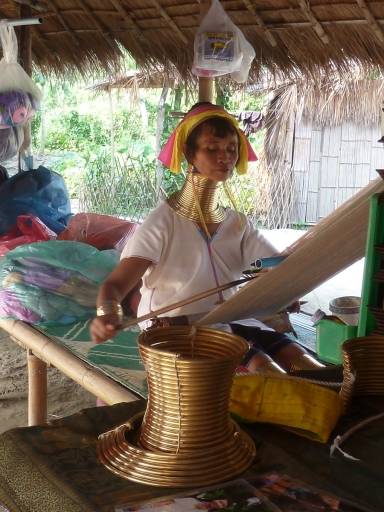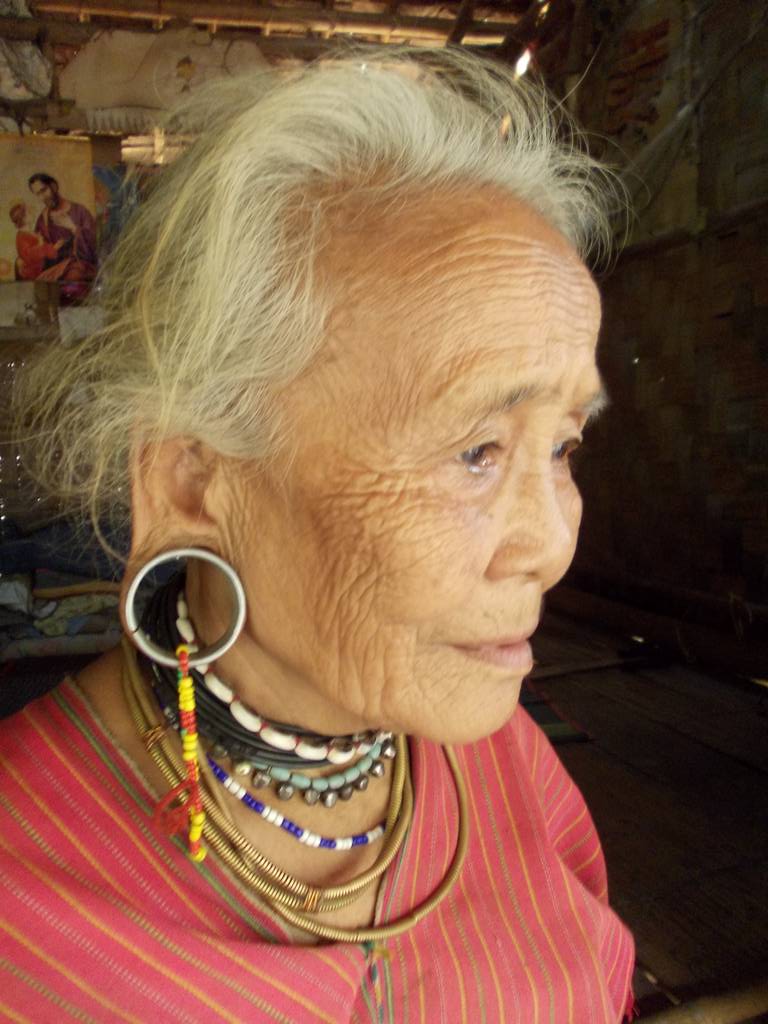While the name Karenni (‘Red Karen’) is taken from the brightly-coloured clothing of the largest ethnic group, the Kayah, there are over a dozen ethnic Karenni subgroups that inhabit the region (Smith, 1994). Perhaps the most well-known Karenni subgroup is the Padaung (Kayan), due to the traditional practice of Kayan women extending their necks through the use of brass rings. Other main subgroups among the Karenni are Kayah, Geko, Geba, Bres, Manumanaw, Yintale, Yinbaw, Bwe, and Paku (Thein Lwin, 2011).
The Karenni originate from Mongolia from where they arrived to Burma around 700 BC (Thein Lwin, 2011). Although all Karenni subgroups speak the same Karenni language, dialects vary from one group to another. There are also three different types of written Karenni language, one using the Burmese alphabet, one the Roman alphabet, and one the Kayah Li alphabet (Thein Lwin, 2011). Kayah Li is taught at schools in Karenni refugee camps along the Thailand-Burma border.
While most Karenni are Christians, some are Buddhists, and there is also a Buddhist Shan minority in the state (Ekeh & Smith, 2007). The Karenni have several festivals and holidays, the most important of which is Kay Htoe Bo, a traditional celebration held on a date confirmed by a fortune teller.
The Karenni State is Burma’s smallest and it rivals the Chin, Wa and Naga regions in its poverty and lack of development. Over half a century of mistreatment and neglect has left the state with poor infrastructure, inadequate health care, malnutrition and little or no social and economic development (Centre for Peace and Conflict Studies, 2010). Karenni state also suffers from a disproportionate lack of education opportunities, illiteracy is widespread and the number of schools, teachers and students is the lowest in Burma (see Background information; Karenni Homeland).
Politically, the situation in the Karenni State represents one of Burma’s most complex problems. Along with the Karen, Kachin, and Chin, the Karenni fought alongside the British forces in World War II. While the British gave their word to protect the Karenni in the future, as with the Karen, this was a promise they soon reneged on. In February 1947, General Aung San and some members of the Frontier Area signed the Panglong Agreement, accepting the accession of their states to Burma with the intention of forming an independent Union of Burma. Karenni leaders were not interested in the agreement as they wanted to pursue their dream of self-determination. The Karenni thus felt that they were subsequently forcefully incorporated in to the country. According to Karenni homeland website:
“Karenni has been under illegal Burmese occupation since the Burmese Government invaded their independent state on 9th August 1948” (Background information, Karenni Homeland).
While the 1947 Constitution granted the Karenni, along with the Kachin and Shan, a certain amount of autonomy and the right to cession after ten years, this pledge was never honoured. In August 1948, the same year that Burma gained its independence from the British, the Karenni leader U Bee Htu Re was captured and assassinated by the government military police (for Karenni history, see Background information, Karenni Homeland; Smith, 1994). This tragic event caused an armed insurgency that quickly swept through the state, including fighting between the Karenni who supported the AFPFL government and those who did not. Fighting in the state has continued ever since.
Armed groups in the state include Karenni National Progressive Party (KNPP), Karenni National Democratic Party (KNDP), Kayan New Land Party (KNLP), Kayan National Guard (KNG), Karenni National Liberation Front (KNLF), and Karenni National Peoples Liberation Front (KNPLF). The KNPP has been at the forefront of the armed Karenni struggle since it was founded in 1957. KNPP also runs a de-facto government and organises aid to the oppressed Karenni people, offering health care, education, welfare and protection to local populations and IDPs. The Burmese army has successfully persuaded some armed groups, such as the KNPLF and KNDP, to break away from the KNPP and join the government, thus splitting the opposition and resulting in some Karenni groups to fight each other.
Under the Burmese government’s Four Cuts campaign, entire communities were forcibly relocated in the Karenni state, producing large numbers of refugees and displaced people in the mountains and the jungle. Particularly heavy fighting ensued between 1994 and 2000 when thousands of Karenni were internally displaced in the state, or fled to Thailand to one of the refugee camps along the border. An estimated 14,000 Karenni refugees (11.6% of the refugees) reside in the refugee camps in Thailand (TBC, August, 2014).
According to an interview survey conducted in 2009, many Karenni feel that the Burmese government has exercised a policy of ethnic cleansing towards ethnic nationality groups in Burma, especially the Karenni (Centre for Peace and Conflict Studies, 2010). Due to historical reasons and the current situation, many Karenni hold negative stereotypes and prejudice against the Burman who are often perceived as being an extension to the Burmese military.
Some so-called development projects have reportedly led to serious environmental degradation and deforestation in the Karenni State, seriously hampering traditional agricultural and economic activities (Ekeh & Smith, 2007). While the state is relatively rich in natural resources, the local population report next to no benefits from natural resource extraction that takes place in the region. On the contrary, the people are often forced to work on projects without gaining any benefits. Tens of thousands of villagers across the state have been forced to work as porters or on government labour projects. Karenni communities also report feeling unsafe and insecure due to the presence of government spies and informers, and there is also much concern over the government’s attempt to divide the people and to corrode traditional cultures (Centre for Peace and Conflict Studies, 2010). The Karenni have tried to revive and maintain their culture through practices such as founding the Kayan Literature Committee in 2000 to promote unity, culture and literature in the Karenni State. As a result of continuing human rights violations and poor opportunities, many Karenni leave the state especially to live in neighbouring Thailand.

Road to a Burmese Karenni village near Mae Hong Son on the Thailand-Burma border. (Photo: Chris Smith)
The overall humanitarian situation in the Karenni State has not improved. Burmese government does not allow foreigners to travel to Karenni State, and there is no access for third party impartial observers or legitimate humanitarian aid. Human rights violations include forced labour, land confiscation, torture, arbitrary executions, and sexual violence (Ekeh & Smith, 2007). According to TBC (2013c), 35,000 remain internally displaced in the state. No one knows how many people have died as a result of armed conflict and abuse.
Updated October 17, 2014
Continue to Shan

